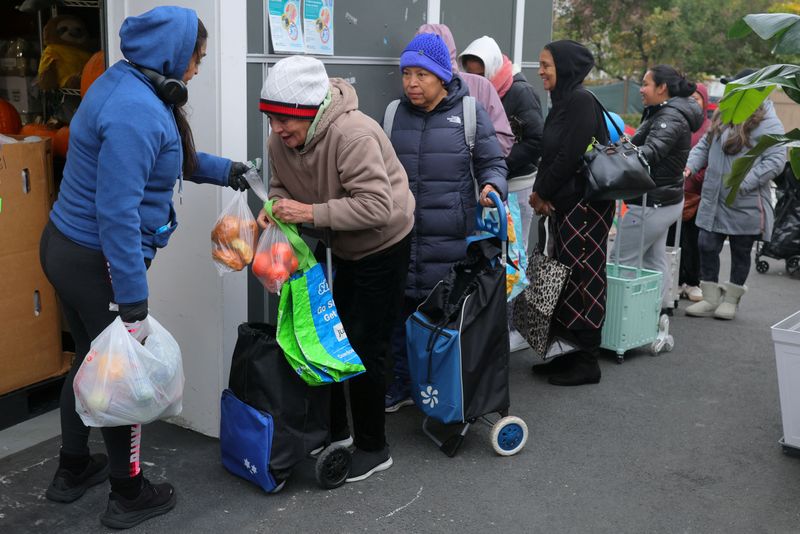By Leah Douglas
WASHINGTON (Reuters) -For Roma Hammonds, of Chattanooga, Tennessee, food stamps have been a lifeline since taking custody of her grandchildren five years ago.
Hammonds, 60, who cannot work because of a physical disability, has relied on her $563 in monthly Supplemental Nutrition Assistance Program benefits to feed her family of four and to afford other bills like rent, she said.
But her November benefits may not be issued by the U.S. government due to the ongoing federal shutdown, and Tennessee is among the vast majority of states that have said they cannot pay for the aid themselves.
“I don’t know what I’ll do,” Hammonds said.
Hammonds is one of the roughly 41 million SNAP recipients wading into a potential historic lapse on Saturday of the 60-year-old food aid program, which sends roughly $8 billion each month to low-income Americans in every state.
Neither Congress nor the administration of President Donald Trump has acted to fund benefits. Two federal judges on Friday ruled that the administration cannot block November SNAP benefits and must use about $5 billion in agency contingency funds to pay for them, requiring updates by Monday on compliance with their rulings.
The U.S. Department of Agriculture did not respond to questions about how it will react to the ruling or share any details of a plan to pay benefits.
In the meantime, just five states, Delaware, New Mexico, Louisiana, Virginia and Vermont, and the District of Columbia have said they will pay for some or all of the November food aid, according to a Reuters review of state websites and public statements. The rest have said they will not pay for the benefits due to technical or cost barriers, or provided no explanation.
The USDA said in an October 24 memo that it will not reimburse states if they cover the cost of benefits.
Most states balance their budgets annually or biennially, and the increased uncertainty of federal funding for healthcare, education and other key resources has added layers of risk to state finances, according to the Pew Charitable Trusts.
“Every year we have significant budget shortfalls and are working to balance the budget,” said Christine Woody, food security policy manager at Empower Missouri, a social justice organization. “We don’t have $130 million to put towards this without any assurance.”
A USDA spokesperson called the shutdown an “inflection point for Senate Democrats.” The agency has repeatedly blamed the aid lapse on Democrats, most of whom have withheld their votes on a spending bill in an effort to keep healthcare costs from spiking for many Americans. Democrats have criticized the USDA for not using agency contingency funds to partially fund the November benefits.
MULTI-MILLION-DOLLAR GAPS
States receive huge monthly sums from the federal government for SNAP benefits, ranging from $4.9 million for Wyoming to more than $1 billion for California, according to USDA data.
To distribute those benefits, states contract with third-party processors who add the money to recipients’ Electronic Benefit Transfer cards. Some states have said they cannot make the technical changes needed to get money to recipients themselves.
“Tennessee is unable to utilize state dollars to provide the benefit, as states do not have a mechanism to load benefits onto customer cards,” said Governor Bill Lee in an October 24 statement.
Others said the sums are simply too large to accommodate. “SNAP brings in more than $210 million monthly in federal funding. The state budget cannot absorb even one month of federal failure,” said a notice on the Massachusetts Department of Transitional Assistance website.
Virginia is drawing on a budget surplus for its stop-gap program that will issue weekly benefits through at least November, Governor Glenn Youngkin said this week. Virginia SNAP benefits cost about $143 million per month, according to USDA data.
Delaware on Wednesday said it would fund week-by-week benefits through November if needed. Louisiana, Vermont and New Mexico are making funds available for partial benefits.
Some states, including Connecticut, New Mexico and West Virginia, have said they will send additional money to food banks. Food banks are already under strain from rising U.S. hunger rates and have said they are unlikely to be able to meet surging demand during the benefit lapse.
Many states encouraged SNAP recipients to budget and visit food pantries, and others to donate time and money during the benefit lapse.
“Let’s do everything we can to support one another so that no family goes hungry,” said the Arkansas Department of Human Services website.
BIPARTISAN BLAME
Some Democratic-led states have blamed the Trump administration for the lapse, while some Republican-led states blamed Democrats in Congress.
North Carolina Governor Josh Stein, a Democrat, said the administration is at fault because of its decision not to use the emergency funds.
“The administration’s refusal to use these available funds as temperatures cool and the Thanksgiving holiday approaches is a cruel abdication of the responsibility to support families and communities,” Stein said in an October 27 statement.
The website of Louisiana Governor Jeff Landry, a Republican, blamed Democratic Senators for withholding their votes on a spending bill.
“Our U.S. Senators representing Louisiana have voted over and over again to re-open the government. They are doing their part. Now it is time for those U.S. Senators, voting under Democrat Senate Leader Chuck Schumer, to vote yes and re-open the federal government,” the website said.
Thirteen Senate votes to fund the government have failed.
(Reporting by Leah Douglas in Washington; Editing by Aurora Ellis)

